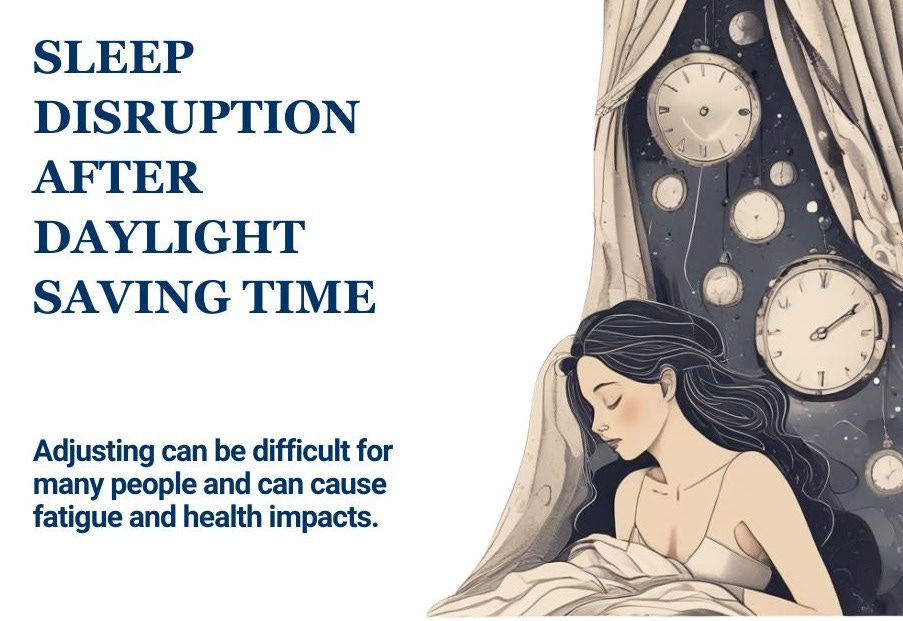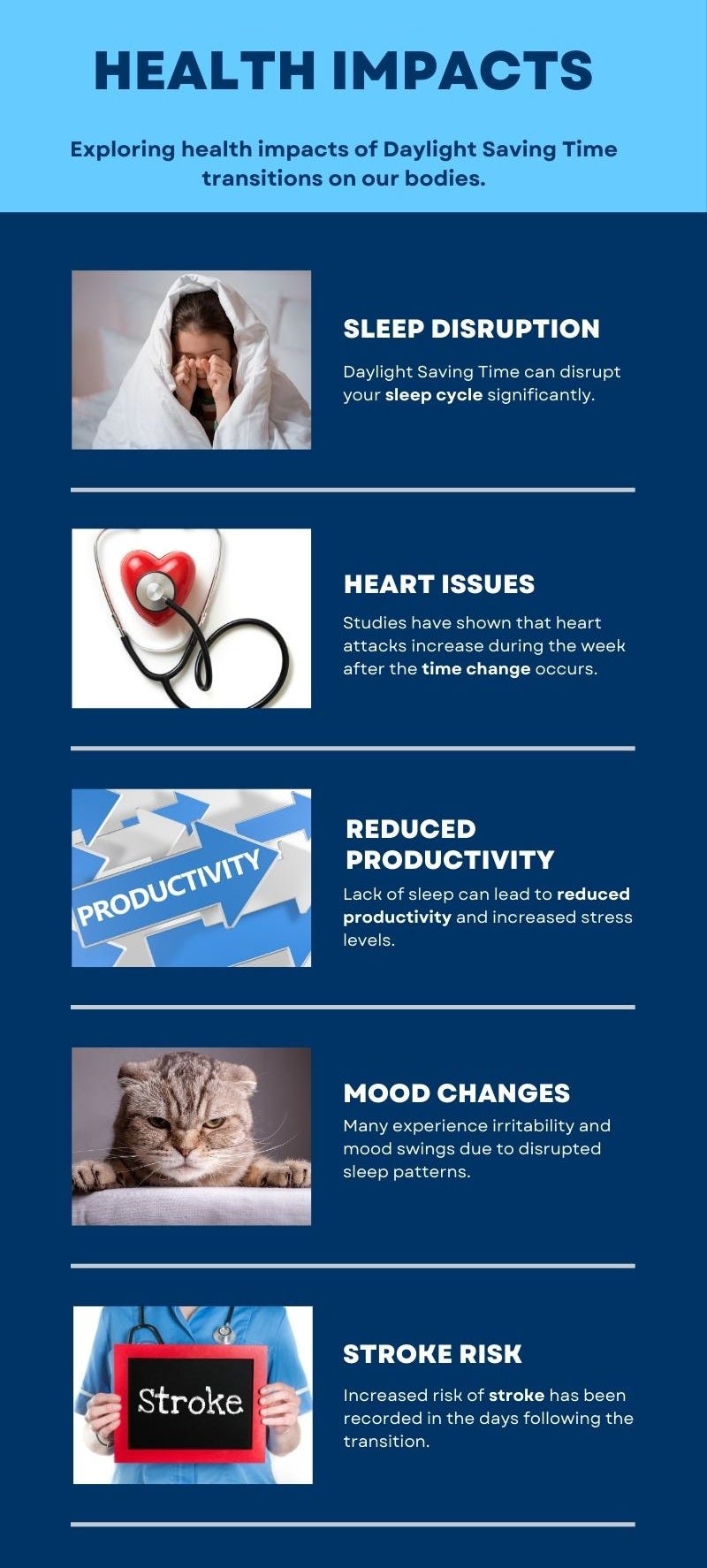On Sunday, March 9, most of us in the U.S. will move our clocks ahead by one hour. While “springing forward” sounds energetic, the reality is far from it; this shift disrupts our natural sleep patterns and throws our bodies off balance.
I used to think losing just one hour wouldn’t make much of a difference. But every year— particularly as I’ve gotten older—I find myself groggy, struggling to focus, and wondering why my energy has vanished. Sound familiar?
While many of us might just power through with an extra cup of coffee, certain groups—especially older adults and postmenopausal women who might already face sleep challenges—can find the Daylight Saving Time transition particularly tough.
So instead of just accepting the groggy Monday morning ahead, let’s look at some practical ways to protect the consistency of our sleep-wake cycles during this time transition.
Consistency: The Real Secret to Quality Sleep
If there’s one thing I’ve learned in studying sleep patterns, it’s that consistency is absolutely essential for quality sleep. Sleep isn’t just about getting your 7 to 8 hours—it’s about maintaining a consistent sleep schedule. Going to bed and waking up at the same times every day—yes, even on weekends—is perhaps the single most important factor in maintaining healthy sleep.
Our bodies thrive on predictability. Our circadian rhythm regulates everything from sleep and hormone release to metabolism and immune function. When we maintain consistent sleep and wake times, our internal clock runs smoothly—helping us fall asleep faster, stay asleep longer, and wake up feeling more refreshed.
When we suddenly shift this schedule during Daylight Saving Time—even by a seemingly measly hour—it’s like giving our biological system an unexpected jolt. The result? Fragmented sleep, brain fog, and midday energy crashes.
Studies Highlighting the Importance of Consistent Sleep Schedules
Recent studies have highlighted the alarming connection between inconsistent sleep schedules and increased mortality risk:
Research using data from the UK Biobank revealed that individuals with highly irregular sleep patterns faced a 53% higher risk of all-cause mortality compared to those with median sleep regularity.
Similarly, a study utilizing the Multi-Ethnic Study of Atherosclerosis sleep data found that participants maintaining a "regular-optimal" sleep pattern had a 39% lower mortality risk than those with “irregular-insufficient” sleep habits.
Furthermore, a large-scale study involving over 60,000 UK Biobank participants demonstrated that higher sleep regularity was associated with a 20%-48% lower risk of all-cause mortality.
Finally, a review article published in 2025 examined the impact of poor sleep quality on cardiovascular risk factors and quality of life. This review highlighted the relationships between insufficient or disrupted sleep and various health outcomes, including cardiovascular disease, blood pressure issues, obesity, and metabolic syndrome.
These studies consistently demonstrate that irregular sleep patterns are associated with increased mortality risk—although the specific percentages vary depending on the study design, population, and how sleep regularity was measured.
Daylight Saving Time directly assaults this consistency, forcing an abrupt change to our established patterns. And this is precisely why it’s problematic for our health.
The Case Against Clock-Changing
The more I learn about sleep science, the more convinced I am that we should end Daylight Saving Time once and for all. Why can’t we just pick standard time or daylight time and stick with it? Either option would be preferable to this twice-yearly upheaval that throws our carefully cultivated sleep routines into chaos.
I don’t really care whether we have more daylight in the morning or in the evening. My problem lies with the unavoidable disruption of my sleep schedule.
This isn’t just my personal preference. The scientific community increasingly recognizes that these transitions exact a measurable toll on public health. The American Academy of Sleep Medicine recommends eliminating seasonal time changes in favor of a fixed, national, year-round standard time. The evidence suggests we’d be better off eliminating the switches entirely, regardless of which time standard we ultimately adopt.
The Health Impacts of That “Just One Hour”
That single hour we lose during Daylight Saving Time might seem trivial in the grand scheme of things, but the science suggests otherwise:
Heart health takes a hit: Heart attack rates jump by 24% on the Monday following Daylight Saving Time, according to a study in the American Journal of Cardiology.
Stroke risk increases: Studies also show a concerning rise in strokes immediately following the time change.
Mental Fog and Mood Disruptions: Sleep deprivation can lead to heightened stress, irritability, and decreased concentration. That foggy feeling isn’t your imagination: sleep deprivation genuinely affects concentration, stress levels, and even safety (workplace accidents and car crashes both spike after DST).
Blood Sugar and Metabolism: Sleep disruption can cause higher blood sugar levels and increased hunger hormones, leading to cravings for processed foods.
Health impacts of the Daylight Saving Time transition include increased heart attack risk, stroke risk, and disrupted sleep patterns.
Older Adults and Postmenopausal Women Are Most Affected
If you’re in either of these groups, you’re probably nodding right now. The natural aging process already alters sleep patterns, making it harder to fall asleep and stay asleep through the night.
For postmenopausal women specifically, hormonal shifts, increased anxiety, and night sweats can make quality sleep elusive even under normal circumstances.
After menopause, declining estrogen and progesterone levels can make it harder to fall and stay asleep. These hormones play a role in regulating body temperature, stress response, and circadian rhythms. This is why many postmenopausal women experience more frequent awakenings, night sweats, and even insomnia—challenges that Daylight Saving Time only worsens.
Melatonin, Aging, and Sleep Disruptions
Melatonin, often called the sleep hormone, helps regulate our circadian rhythm, signaling when it’s time to sleep and wake up. However, melatonin production naturally declines with age, making it harder to fall and stay asleep.
For postmenopausal women this decline is often even more pronounced. Research suggests that estrogen and progesterone influence melatonin production, meaning that after menopause—when these hormone levels drop—melatonin levels may also fall more sharply. This can lead to:
Difficulty falling asleep
More frequent night awakenings
Lighter, less restorative sleep
Since Daylight Saving Time further disrupts circadian rhythm, postmenopausal women may find it even harder to adjust. Supporting natural melatonin production—through morning sunlight exposure, reducing blue light at night, and maintaining a consistent sleep schedule—can help smooth the transition.
Your Pre-DST Game Plan(For Friday and Saturday)
Since we have only a couple of days before the switch happens, here’s what you can do right now to prepare:
Shift Your Sleep Gradually: Go to bed 15-20 minutes earlier tonight and tomorrow night to give your body a gentler transition.
Get Morning Sunlight: Get outside first thing tomorrow morning. Morning sunlight helps reset your circadian rhythm and boosts serotonin levels.
Reduce Evening Light Exposure: Start dimming your lights earlier in the evening and put those devices away at least an hour before bed (to improve your melatonin production).
Support Sleep with Magnesium: I’ve found applying magnesium oil to my feet or shoulders before bed helps with muscle relaxation and deeper sleep. You can also take magnesium glycinate before bed to help facilitate restful sleep. Magnesium helps relax muscles, reduce stress, and improve sleep quality.
Adjust Your Diet: Eat earlier and eat sleep-supporting foods like almonds, bananas, avocados, and salmon. Avoid late-night caffeine, eating late, and alcohol, all of which can further disrupt sleep.
Post-DST Recovery Plan (Sunday and Beyond)
Once we’ve made the switch, here’s how to help your body maintain that all-important consistency:
Stick to a Consistent Sleep Routine: Get up and go to bed at the same time daily, even on weekends. This is your strongest defense against Daylight Saving Time disruption.
Get Outside First Thing in the Morning: Natural sunlight helps reset your body clock faster. Get outside (or at least look out the window at sunlight) within an hour of waking.
Take a Short Nap if Needed: A 20-minute power nap in the afternoon before 3 PM can help, but avoid long naps that may delay bedtime.
Hydrate and Move Your Body: Drink plenty of water and do light exercise like walking or yoga to maintain energy levels.
Be Cautious While Driving: Sleep loss contributes to higher accident rates, so be extra alert on the road.
The National Sleep Foundation recommends treating the days following Daylight Saving Time as if you’re recovering from jet lag—because in many ways, that’s what your body is experiencing.
Can You Make Up for Lost Sleep?
Contrary to popular belief, you can’t fully “catch up” on lost sleep by sleeping longer on the weekend. However, you can minimize the impact of sleep debt by:
Prioritizing earlier bedtimes for several nights after the switch.
Taking strategic short naps when needed.
Being extra vigilant about sleep hygiene (keeping devices out of the bedroom, maintaining comfortable sleeping temperatures, etc.).
Most importantly, get back to a regular, consistent sleep schedule as quickly as possible.
If you’re unsure how much DST affects your sleep, try tracking your sleep patterns for a week using a journal or a sleep-tracking app. Note what time you go to bed, how many times you wake up, and how refreshed you feel in the morning. This can help you spot patterns and adjust accordingly.
Will We Ever Stop Changing Our Clocks?
The Daylight Saving Time debate continues, with many health organizations advocating for permanent standard time based on evidence that circadian misalignment increases various health risks.
While legislation to eliminate the time change has been introduced multiple times at the federal level in the United States, we’re still waiting for nationwide changes. Some states like Florida and California have passed bills to remain on permanent Daylight Saving Time, but these require federal approval before taking effect.
For now, the twice-yearly clock change remains our reality—which makes having a personal adjustment strategy all the more important.
The Bottom Line
Daylight Saving Time isn’t just about losing an hour of sleep—it’s a significant disruption to our body’s carefully calibrated rhythms and the consistency that quality sleep demands. While we can’t avoid Sunday's clock change, we absolutely can take steps to make the transition gentler on our systems.
By implementing these small adjustments before and after Daylight Saving Time, prioritizing sleep consistency, and supporting our bodies with the right nutrition and habits, we can navigate this transition with minimal disruption to our health and energy.
Have you found any tricks that help you adjust to Daylight Saving Time? Do you struggle more with sleep as you’ve gotten older? Drop a comment below to share your experience and what works for you!







I feel like I got the crap out of me this morning and I do all of the hygiene habits for sleep.
It's barbaric. "They" are aware of how disruptive changing the time back and forth is, and yet continue to do so. I don't care what direction they decide. Do something and stick to it.
I followed a plan a week before the change, and I'm still yucky. Bureaucracy at its finest. Not!
Great article, Daria. Excellent researching. :) I love Mathew Walker, and listen to him every chance I get. Too bad the powers at be do not.